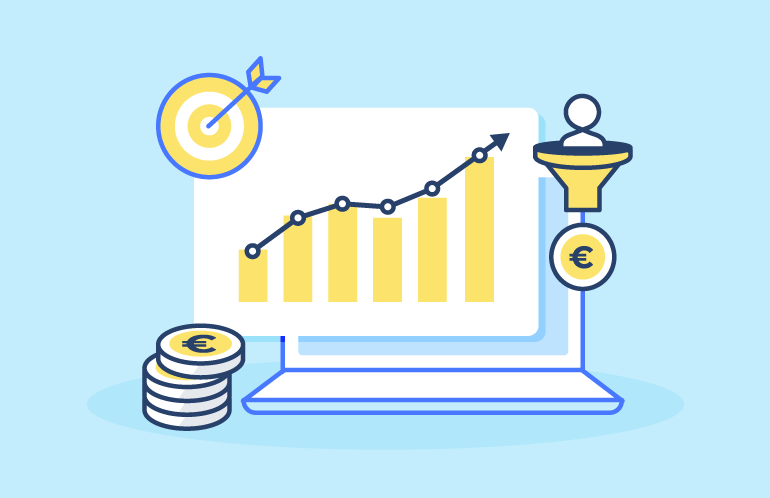CDP: what ROI can you expect from a Customer Data Platform?


Category: Data
Customer Data Platforms (CDP) represent a significant evolution in the field of digital marketing, playing an essential role for companies seeking to make the most of their customer data. These platforms offer an integrated solution for collecting, organizing and activating customer data in a holistic way. As more and more companies recognize the importance of these technologies in refining their understanding of customers, the central question that is emerging is how much return on investment (ROI) can really be achieved with a Customer Data Platform.
The quest for return on investment (ROI) from a Customer Data Platform (CDP) is part of a complex equation where the cost of the project meets the benefits generated by its deployment. Answering this crucial question requires a deep understanding of both the cost, encompassing the deployment and operation of the CDP, and the concrete results this platform can generate, whether monetary or non-monetary in nature. This exhaustive analysis enables us to assess the long-term profitability of the project, and to anticipate the investments needed to make the most of the data platform.
One of the questions most frequently asked by companies is how long it will take for the investment in a CDP to pay off. It's important to stress that the speed of return on investment can fluctuate depending on the particular use case. For applications such as message enrichment or the creation of a data hub for business applications, the payback period can range from 6 to 12 months.
Let's delve into the concrete and abstract benefits that the strategic implementation of CDP can bring to a company. Beyond its financial implications, CDP emerges as a powerful catalyst, influencing organizational effectiveness as a whole.
The benefits of CDP are not limited to monetary figures. By streamlining customer data management, it contributes to a tangible improvement in operational efficiency. Fewer errors linked to out-of-sync or obsolete data translate into lower operational costs. A more fluid and responsive organization emerges, enabling teams to concentrate on higher value-added tasks.
By providing advanced analyses based on consolidated data, CDP becomes a valuable source for informed decision-making. The insights generated enable a deeper understanding of customer behavior, market trends and emerging opportunities. This in-depth knowledge confers a competitive edge by accurately anticipating market evolutions, enabling the company to remain agile and proactive.
Another key aspect of CDPs, directly influencing ROI, is their ability to improve operational efficiency. By streamlining the data management process, CDPs enable marketing and sales teams to save valuable time, while reducing the risk of errors linked to out-of-sync or obsolete data. This increased operational efficiency often translates into lower costs and more judicious use of resources.
In financial terms, CDP stands out as a driver of revenue growth. Its ability to aggregate and centralize customer data creates a solid foundation for advanced personalization of customer interactions. By offering tailor-made customer experiences, CDP intensifies engagement, fosters deeper relationships and leads to more frequent conversions. The targeted marketing campaignsfueled by accurate, up-to-date data, as well as increased customer loyalty, translate directly into significantly higher revenues.
Significant ROI after implementing a CDP depends on a number of key factors, among which data quality occupies a prominent position. The accuracy, up-to-dateness and completeness of the data managed by CDP are crucial, guaranteeing the relevance of data analysis and marketing actions. It is therefore important for companies to pay particular attention to the maintenance and management of data quality in order to optimize their investment.
A second crucial variable lies in the seamless integration of CDP with other technologies. When effectively integrated with tools such as CRMs, marketing automation platforms and campaign management systems, CDP becomes a key element in the coherent orchestration of data and operations, reinforcing its overall impact.
Finally, maximizing ROI requires competent use of CDP by marketers. Comprehensive training programs are essential to ensure a thorough understanding of the platform's functionalities, and to enable teams to take full advantage of its potential to achieve specific business objectives. Investment in staff training thus becomes a strategic lever to guarantee the long-term success of CDP use within the company.
The return on investment (ROI) of a Customer Data Platform can exert a significant and versatile influence on various aspects of business operations. However, to fully exploit the potential of a CDP, companies are advised toadopt a holistic approach. This means not only investing in the technology itself, but also focusing on data quality,systemic integration and the development of marketers' skills. Properly deployed, CDP transcends its status as a technological tool to become the catalyst for successful and sustainable digital transformation within marketing teams. This global vision reinforces CDP's position as an essential driver of digital innovation and continuous optimization of operational processes.
Contents